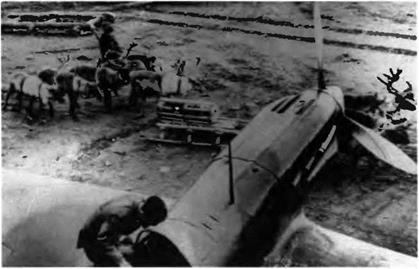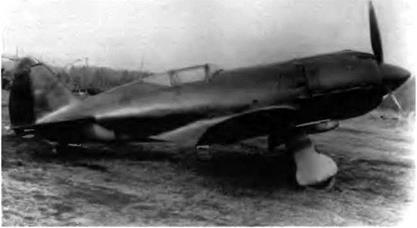MiG-3 with AM-38 Engine
In an attempt to correct the inadequacy of the MiG-3 at low and medium altitudes, the AM-35A was replaced by the AM-38, the only available engine that could give the aircraft the means to stand up to the Messerschmitt Bf 109Fs first encountered in June 1941. Installing the AM-38 in the MiG-3 required few modifications, since the weight and overall dimensions of both engines were almost identical. The AM-38 afforded 1,178 kW (1,600 ch) at takeoff, and its maximum rating at
2,0 m (6,560 feet) was 1,141 kW (1,550 ch).
A production MiG-3 was reengined in this way and somewhat modified by reshaping the exhaust pipes, removing the bomb racks, and suppressing the inert-gases transfer system. The aircraft was ready at the end of July 1941, and it went up for its maiden flight at the beginning of August with an LII pilot, Yu. K. Stankevich. The flight test program was carried out by Nil VVS pilots A. G. Kochetkov, A. G. Kubishkin, and A. M. Popyelnushenko as well as LII pilots such as G. M. Shiyanov and A. V. Yumashev Tests ended on 17 August. They showed that the reengined fighter was a sound machine if flown in ambient temperatures lower than 16-20° C (61-68° F), but the engine cooling system had to be modified for use in higher temperatures. The
|
An anachronistic scene: supplies were delivered on this MiG-3 airbase on sleds pulled by reindeer. |
test report concluded, "Below 4,000 m [13,100 feet], the АМ-38-engined MiG-3 offers new tactical possibilities and can successfully face the enemy fighters at low and medium altitudes." The time required for a 360-degree turn had dropped to between twenty and twenty-one seconds. Considering this laudatory appraisal, series production of the aircraft was recommended. But this plan too was thwarted by the unavailability of the AM-38 engine, which was still reserved for the 11-2 assembly lines. However, a repair workshop fitted a small number of MiG-3s with overhauled AM-38s because no more AM-35As could be found. Some of these MiG-3s were equipped with two synchronized 20-mm ShVAK cannons (100 rounds each) to fight in PVO units.
Specifications
Span, 10.2 m (33 ft 5.6 in); length, 8.25 m (27 ft 0.8 in); height in level flight position, 3.325 m (10 ft 10.9 in); wheel track, 2.78 m (9 ft 1.4 in); wing area, 17.44 m2 (187.72 sq ft); empty weight, 2,582 kg (5,692 lb); takeoff weight, 3,225 kg (7,110 lb); fuel, 463 kg (1,020 lb); oil, 45 kg (99 lb); wing loading, 185 kg/m2 (37.9 lb/sq ft).
Performance
Max speed, 587 km/h at 3,000 m (317 kt at 9,800 ft); 592 km/h at
4,0 m (320 kt at 13,000 ft); max speed at sea level, 547 km/h (295 kt); climb to 5,000 m (16,400 ft) in 7.95 min; service ceiling, 9,500 m (31,200 ft); takeoff roll, 380 m (1,250 ft); landing roll, 400 m (1,310 ft).
|
The ОКБ tried to prolong the life of the MiG-3 at all costs, but matching a radial engine with an airframe engineered for an in-line engine raised too many difficulties. |












